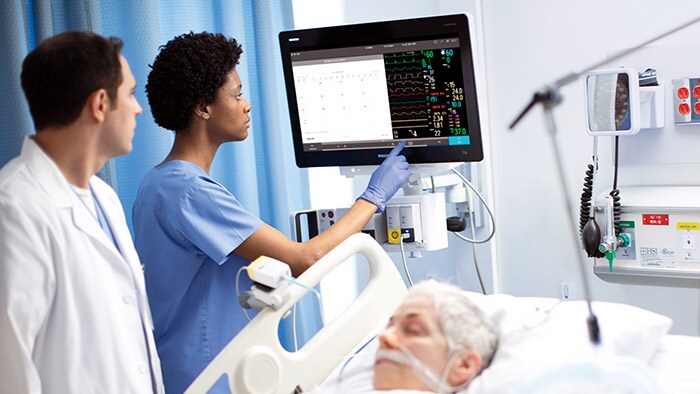The shift from open surgery to minimally invasive procedures continues to provide significant benefits for patients, who typically recover faster and have a better overall treatment experience, and for healthcare providers, who can treat more people at a lower cost. With most of today’s procedures focused on the patient’s cardiovascular system, image-guided therapies are increasingly expanding into new areas including neurology, structural heart disease, oncology and spine surgery. Philips’ Image Guided Therapy business provides complete procedural solutions of systems, smart devices, disease-specific software and services for minimally invasive procedures. Helping caregivers decide, guide, treat and confirm the right therapy for each patient during their procedure, the business is making a significant contribution towards Philips’ ambition to improve the lives of 3 billion people a year by 2030. In this interview, Bert van Meurs, Chief Business Leader for Image Guided Therapy, gives an update on the businesses’ strategic development and discusses the impact of COVID-19 on interventional procedures worldwide.
Q: Can you outline the strategic direction of Philips’ Image Guided Therapy business? BvM: Philips has played a pioneering role in image-guided minimally invasive therapy for cardiovascular disease since the inception of the field back in the 1950s. While we began on this journey thanks to our expertise in X-ray imaging systems, today we’ve grown to provide complete procedural solutions of systems, smart devices and disease-specific software for image-guided cardiovascular therapies, and increasingly we’re extending into other disease areas. Innovation today is not driven by a single technology or imaging modality in isolation. Rather, it is by integrating different technologies and different sources of information that we can truly innovate across the whole procedure. For example, today we offer advanced pressure wires that perform physiologic measurements to identify whether to treat a blockage in a coronary artery. We can overlay those measurements – captured in the vessel itself – with live X-ray images, integrating the two sources of information in an intuitive way that makes it easier for the clinician to decide where they need to treat. The pace of change in image-guided therapies has driven a quiet revolution in healthcare: we’ve gone from open surgery that required patients to spend weeks in hospital to minimally invasive procedures where they can go home the next day, and even sometimes on the same day as the procedure. But what really excites me is the innovation journey that lays ahead of us: from entirely new forms of imaging, to augmented reality, to bringing it all together in a seamless and intuitive way for clinicians, this is a field full of great possibilities. As an innovation-focused company and a leader in this field, we will continue to play an important role in advancing the ‘quadruple aim’: better health outcomes, an improved experience for the patient and for staff, and a lower cost of care.
The pace of change in image-guided therapies has driven a quiet revolution in healthcare: we’ve gone from open surgery that required patients to spend weeks in hospital to minimally invasive procedures where they can go home the next day, and even sometimes on the same day as the procedure.
Q: We’re now several months into the global COVID-19 pandemic. How has your response evolved in that time? BvM: At the beginning of the pandemic a similar pattern unfolded around the world, with healthcare systems prioritizing the fight against COVID-19 above all else. As a result, almost all non-urgent image-guided procedures were suspended. That has had two major effects. Firstly, patients who need important, and in the longer-term often lifesaving procedures, are having to wait longer. Secondly, a significant part of healthcare providers’ treatment workload, and therefore revenues, has dried up, resulting in severe financial stress. As the situation stabilizes in many parts of the world, we are supporting these providers to get back on track. As a company, our strategy remains unchanged, and our mission to improve lives is more important than ever. The major trends we already see in healthcare – digitalization; the shift from volume to value – are being accelerated by the pandemic. The need to improve workflow and increase efficiency, a key driver for innovations on our Azurion image-guided therapy platform and across our portfolio, is now even more acute, with the pandemic placing significant additional financial pressure on healthcare providers. We are adapting how we serve our customers. We see an increasingly important role for remote solutions in the interventional lab both for operational and clinical support, from cloud-based training on virtual machines to remote support and guidance for individual patient cases during the procedure. For example, our team in India recently used live video streaming to remotely support a coronary intervention with intravascular ultrasound (IVUS) at a hospital in Mumbai, amidst the world’s largest COVID-19 lockdown. Such ways of working will become increasingly common worldwide. Another important trend that we expect the pandemic to accelerate is the shift of procedures to settings outside of the hospital. As the field of image-guided therapy has advanced, some procedures have become more routine, which means that they can be carried out in outpatient settings such as office-based labs (OBLs) or ambulatory surgery centers (ASCs). These facilities, which have been growing in number in the U.S. for over a decade and are now becoming more widespread in other parts of the world, can help to relieve pressure from hospitals and offer an alternative for patients who would otherwise suffer from a delay in care. In the US, where the trend is most advanced, these labs are already playing a role in providing continuity of treatment during the pandemic.
Q: How has your role changed during COVID-19? BvM: The most obvious impact is that, like many of my colleagues, I am now working from home, relying on virtual tools to manage the business. Before COVID-19 I spent a lot of my time meeting with customers around the world, as I have done for decades. I’ve continued to prioritize contact with our customers throughout the pandemic, as understanding and reacting to their fast-evolving needs in this challenging period is essential. Ensuring business continuity across our global manufacturing and supply chain is also critical. I’m very grateful to all our employees and the people at our suppliers globally who continue to make our systems and devices each day. It is inspiring to see all the great work happening across the organization as we adapt to new realities, always with the focus on supporting our customers. Together we have created new ways of working that are more efficient, the benefits of which will continue to be felt long after the pandemic.
















